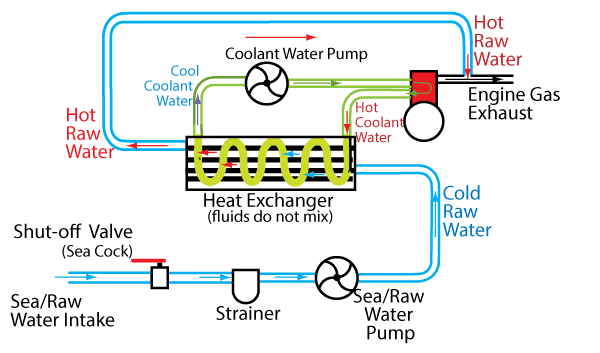
This article is an excerpt from NauticEd’s online Skipper Large Keelboats Course, a comprehensive online sailing course for beginner to intermediate sailors to learn how to sail large sailboats 26 ft (8m) and above. The Skipper Large Keelboats course is part of the Skipper Course Bundle of online courses, also teaching you how to master maneuvering under power and docking!
You can learn to sail and improve your sailing with NauticEd, the international leader in sailing education.
Diesel Raw-Water System
Raw-water means that the water is straight from outside the boat. It might be seawater – it might be lake water. Nothing is done to it other than strain out any seaweed.
The typical elements of the raw water system are:
- Through-hull fitting with seacock valve—capable of being turned on and off. Ensure that it is open whenever the engine is running. Raw water is sucked into the cooling system through this valve.
- Raw water strainer—check for cleanliness.
- Impeller pump—essential to keep the raw water flowing in and exiting.
- Heat exchanger
- Exhaust
Raw water enters the engine through a through-hull fitting and seacock valve. The seacock is a ball valve; the handle should be in the open position any time the engine is running. Normally the valve handle runs parallel with the pipe housing when it is in the open position. Locating this valve handle may sometimes require exploration. Consult your owner’s manual.

Next, the raw incoming water flows through a sea strainer, which is designed to strain out any large particles that may be sucked up from the outside through the seacock. Most often debris is small bits of seaweed or waste.
After the strainer, the raw water flows through the impeller pump. This pumps the raw water forward to the heat exchanger. The pump is usually belt-driven, which needs to be inspected often to insure proper tension with no fraying.
The raw water flows out of the boat through the engine’s exhaust to provide a last bit of cooling to the exhaust. It is important to check for raw water outflow in the engine’s exhaust every time the engine is started. This spurting of exhaust water ensures that hot raw water is flowing through the heat exchanger and effectively cooling the closed water system
Good advice is to include a replacement rubber impeller in your spare parts kit. Preventive maintenance means checking the sea strainer, working the seacock, and replacing the rubber impeller once a year.
You can learn more in the Skipper Course....
Knowledge and theory for longer distances and overnight sailing in diverse conditions. The Skipper Course is a comprehensive online sailing course for beginner to intermediate sailors wanting to learn how to sail larger sailboats 26ft to 56ft. Or upgrade to the Skipper Course Bundle of online courses to also master maneuvering under power and docking!
